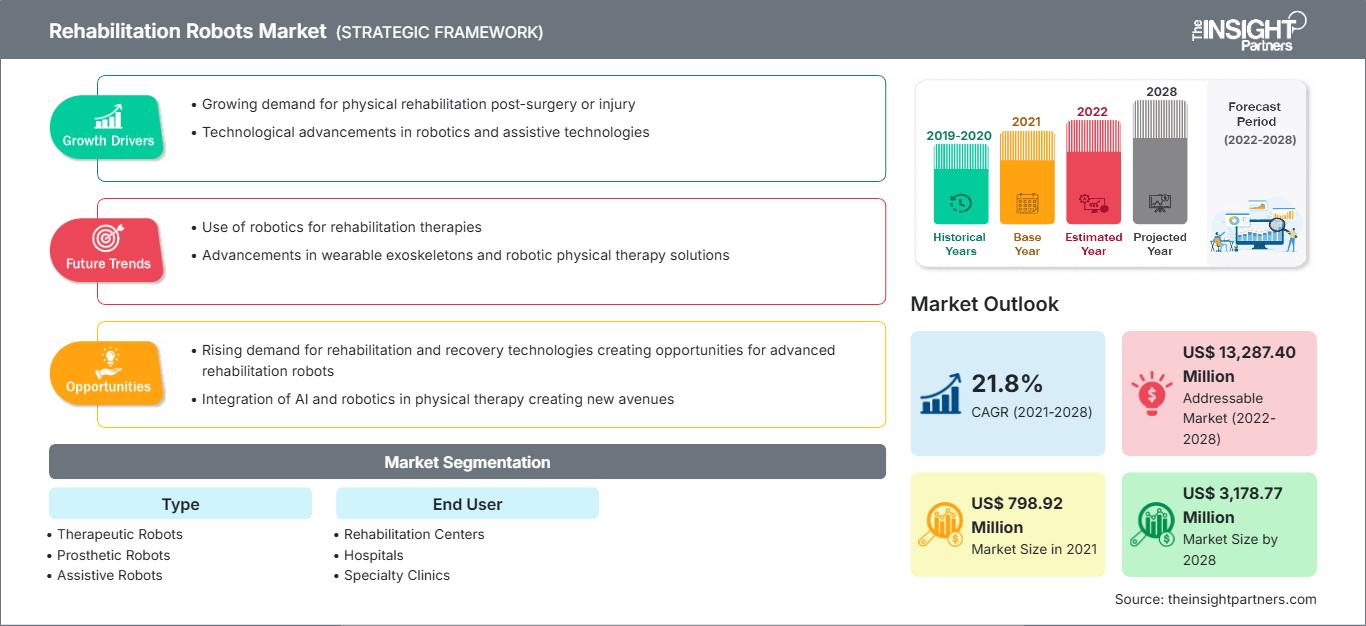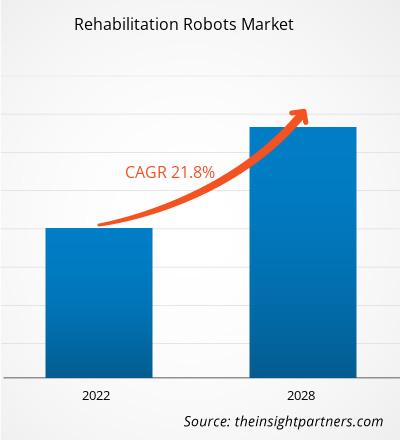Le marché des robots de rééducation était évalué à 798,92 millions de dollars américains en 2021 et devrait atteindre 3 178,77 millions de dollars américains d'ici 2028 ; sa croissance devrait atteindre un TCAC de 21,8 % entre 2021 et 2028.
Les robots de rééducation sont utilisés dans le processus de récupération des patients handicapés pour la verticalisation, le maintien de l'équilibre et la marche. Ces robots doivent suivre le rythme des humains et leurs mouvements ; par conséquent, lors de la fabrication de la machine, les fabricants doivent s'assurer qu'elle suivra les progrès du patient. Le marché des robots de rééducation devrait connaître une croissance significative dans les années à venir en raison de facteurs tels que l'augmentation de la population gériatrique, les accidents vasculaires cérébraux (AVC) et la formation assistée par robot en rééducation. Cependant, le coût élevé de ces appareils freine la croissance du marché.
Analyse du marché
Personnalisez ce rapport en fonction de vos besoins
Vous bénéficierez d’une personnalisation sur n’importe quel rapport - gratuitement - y compris des parties de ce rapport, ou une analyse au niveau du pays, un pack de données Excel, ainsi que de profiter d’offres exceptionnelles et de réductions pour les start-ups et les universités
Marché des robots de rééducation: Perspectives stratégiques

- Obtenez les principales tendances clés du marché de ce rapport.Cet échantillon GRATUIT comprendra une analyse de données, allant des tendances du marché aux estimations et prévisions.
Vous bénéficierez d’une personnalisation sur n’importe quel rapport - gratuitement - y compris des parties de ce rapport, ou une analyse au niveau du pays, un pack de données Excel, ainsi que de profiter d’offres exceptionnelles et de réductions pour les start-ups et les universités
Marché des robots de rééducation: Perspectives stratégiques

- Obtenez les principales tendances clés du marché de ce rapport.Cet échantillon GRATUIT comprendra une analyse de données, allant des tendances du marché aux estimations et prévisions.
Augmentation de la population gériatrique, des accidents vasculaires cérébraux et de la formation assistée par robot en réadaptation
Avec le développement de la recherche en robotique de réadaptation, la fabrication et le déploiement de robots de réadaptation thérapeutique augmentent dans le monde entier. Le Japon et la Chine comptent parmi les pays d'Asie-Pacifique à forte population âgée ; ces pays, ainsi que d'autres pays en développement de la région, sont témoins des progrès de la technologie médicale. Selon le ministère de l'Intérieur et des Communications, environ 35,2 millions de personnes au Japon étaient âgées de 65 ans ou plus en 2017, et ce chiffre devrait atteindre 36,2 millions d'ici 2020. Par conséquent, les grandes entreprises du secteur de la santé sont prêtes à investir dans le développement de technologies avancées pour fournir des soins aux résidents âgés de la région. Par conséquent, l'augmentation de la population âgée et la prévalence croissante des accidents vasculaires cérébraux, rendant les personnes immobilisées, sont parmi les facteurs importants qui stimulent la demande de robots de réadaptation.
La thérapie de rééducation par robot est utilisée pour dispenser un entraînement intensif aux patients souffrant de troubles moteurs causés par des maladies de la moelle épinière ou un accident vasculaire cérébral (AVC). Selon les Centres pour le contrôle et la prévention des maladies (CDC), l'AVC est l'une des principales causes d'invalidité grave à long terme aux États-Unis. La fatigue, l'hémiparésie et les difficultés à marcher sont quelques-unes des conséquences d'un AVC. De plus, les robots de rééducation offrent un entraînement personnalisé, axé sur les tâches, prolongé, intensif, standardisé et reproductible aux patients victimes d'un AVC ou d'autres lésions cérébrales non progressives. Ainsi, la demande croissante de services de santé de meilleure qualité et plus rapides stimule la croissance du marché global des robots de rééducation.
Informations sur les types
Selon le type, le marché des robots de rééducation est segmenté en robots thérapeutiques, robots d'assistance, robots exosquelettes et robots prothétiques. Le segment des robots exosquelettes détenait la plus grande part de marché en 2021 et devrait enregistrer le TCAC le plus élevé au cours de la période de prévision.
Utilisateur final
Le marché des robots de rééducation est segmenté en fonction de l'utilisateur final : hôpitaux, centres de rééducation et cliniques spécialisées. Le segment des centres de rééducation détenait la plus grande part de marché en 2021 et devrait enregistrer le TCAC le plus élevé au cours de la période de prévision.
Les acteurs du marché des robots de rééducation ont largement adopté une stratégie d'innovation produit pour répondre à l'évolution de la demande des clients à travers le monde, ce qui leur permet également de maintenir leur image de marque à l'échelle mondiale.
Aperçu régional du marché des robots de rééducation
Les tendances régionales et les facteurs influençant le marché des robots de rééducation tout au long de la période de prévision ont été analysés en détail par les analystes de The Insight Partners. Cette section aborde également les segments et la géographie du marché des robots de rééducation en Amérique du Nord, en Europe, en Asie-Pacifique, au Moyen-Orient et en Afrique, ainsi qu'en Amérique du Sud et en Amérique centrale.
Portée du rapport sur le marché des robots de rééducation
| Attribut de rapport | Détails |
|---|---|
| Taille du marché en 2021 | US$ 798.92 Million |
| Taille du marché par 2028 | US$ 3,178.77 Million |
| TCAC mondial (2021 - 2028) | 21.8% |
| Données historiques | 2019-2020 |
| Période de prévision | 2022-2028 |
| Segments couverts |
By Type
|
| Régions et pays couverts | Amérique du Nord
|
| Leaders du marché et profils d'entreprises clés |
|
Densité des acteurs du marché des robots de rééducation : comprendre son impact sur la dynamique des entreprises
Le marché des robots de rééducation connaît une croissance rapide, porté par une demande croissante des utilisateurs finaux, due à des facteurs tels que l'évolution des préférences des consommateurs, les avancées technologiques et une meilleure connaissance des avantages du produit. Face à cette demande croissante, les entreprises élargissent leur offre, innovent pour répondre aux besoins des consommateurs et capitalisent sur les nouvelles tendances, ce qui alimente la croissance du marché.

- Obtenez le Marché des robots de rééducation Aperçu des principaux acteurs clés
- Analyse historique (2 ans), année de base, prévision (7 ans) avec TCAC
- Analyse PEST et SWOT
- Taille du marché Valeur / Volume - Mondial, Régional, Pays
- Industrie et paysage concurrentiel
- Ensemble de données Excel
Rapports récents
Témoignages
Raison d'acheter
- Prise de décision éclairée
- Compréhension de la dynamique du marché
- Analyse concurrentielle
- Connaissances clients
- Prévisions de marché
- Atténuation des risques
- Planification stratégique
- Justification des investissements
- Identification des marchés émergents
- Amélioration des stratégies marketing
- Amélioration de l'efficacité opérationnelle
- Alignement sur les tendances réglementaires




















 Obtenez un échantillon gratuit pour - Marché des robots de rééducation
Obtenez un échantillon gratuit pour - Marché des robots de rééducation